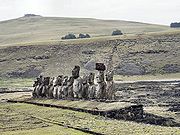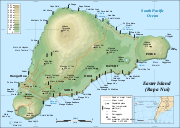
Poike
Encyclopedia
Poike is one of three main extinct volcanoes that form Rapa Nui (Easter Island
) (a Chile
an island in the Pacific Ocean
). At 370 metres, it is the island's second highest peak after Terevaka
.

 Poike forms the eastern headland of Rapa Nui, and there is an abrupt cliff "the Poike ditch" across the island marking the boundary between flows from Terevaka and Poike. Poike last erupted between 230,000 to 705,000 years ago in the Pleistocene
Poike forms the eastern headland of Rapa Nui, and there is an abrupt cliff "the Poike ditch" across the island marking the boundary between flows from Terevaka and Poike. Poike last erupted between 230,000 to 705,000 years ago in the Pleistocene
, and as the oldest of Easter Island's three volcanoes is the most weathered with relatively stoneless soil.
Easter Island
Easter Island is a Polynesian island in the southeastern Pacific Ocean, at the southeasternmost point of the Polynesian triangle. A special territory of Chile that was annexed in 1888, Easter Island is famous for its 887 extant monumental statues, called moai, created by the early Rapanui people...
) (a Chile
Chile
Chile ,officially the Republic of Chile , is a country in South America occupying a long, narrow coastal strip between the Andes mountains to the east and the Pacific Ocean to the west. It borders Peru to the north, Bolivia to the northeast, Argentina to the east, and the Drake Passage in the far...
an island in the Pacific Ocean
Pacific Ocean
The Pacific Ocean is the largest of the Earth's oceanic divisions. It extends from the Arctic in the north to the Southern Ocean in the south, bounded by Asia and Australia in the west, and the Americas in the east.At 165.2 million square kilometres in area, this largest division of the World...
). At 370 metres, it is the island's second highest peak after Terevaka
Terevaka
Ma′unga Terevaka is the largest, tallest and youngest of three main extinct volcanoes that form Rapa Nui...
.


Pleistocene
The Pleistocene is the epoch from 2,588,000 to 11,700 years BP that spans the world's recent period of repeated glaciations. The name pleistocene is derived from the Greek and ....
, and as the oldest of Easter Island's three volcanoes is the most weathered with relatively stoneless soil.
External links
- Guide to Easter Island from the Easter Island Foundation

